Biology and Control of the Strawberry Aphid, Chaetosiphon fragaefolli (Cockerell) (Homoptera: Aphididae) in Florida
Strawberry (Fragaria × ananassa Duchesne) plants can host many aphid species. The true strawberry aphid, Chaetosiphon fragaefolli (Cockerell) (Figure 1), is considered an important pest of cultivated strawberries worldwide, primarily because it transmits viruses such as cytorhabdovirus, also known as strawberry crinkle virus (SCV), one of the most dangerous viruses affecting strawberry (Krczal, 1979) (Figure 2). Recognizing strawberry aphids and the damage they cause is important for successfully implementing control practices.
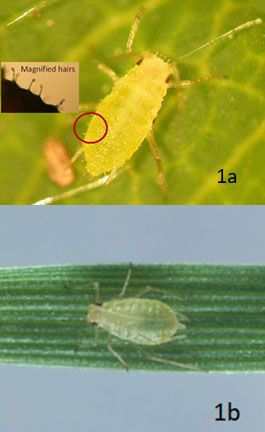
Credit: A) D. Moreau. (AAFC); B) L. Buss (UF/IFAS Dept. of Entomology)
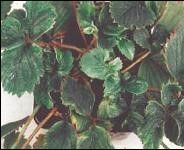
Credit: Posthuma, Kent, UK
Distribution
The strawberry aphid has been reported in the US (California, Michigan, Minnesota, South Carolina, and Washington), Canada, northern Mexico, Europe, Great Britain, South Africa, New Zealand, and Australia (Blackman and Eastop 2000). The state of Florida reported the presence of strawberry aphid in 2004 (Rondon and Cantliffe 2004).
Hosts
The strawberry aphid is frequently found on wild strawberry, Fragaria spp. (especially F. chiloensis in North America), F. vesca, F. virginianana, and Ponsetia anserine L. (Blackman and Eastop 2000; Frazier 1974), although wild strawberry species are not commonly found in Florida. In 2004, it was reported for the first time on cultivated strawberries in Florida, including the cultivars: 'Treasure', 'Earlibrite', 'Strawberry Festival', 'Sweet Charlie', 'FL 97-39', 'Camarosa', 'Carmine', 'Camino Real', 'Diamante', and 'Ventana'. The origin of strawberry aphid in found in Florida strawberries is unknown (Rondon and Cantliffe 2004).
Biology and Description
The strawberry aphid usually occurs on new shoots, in the crown, and close to the veins on the undersides of strawberry leaflets (Figure 3). Nymphs and adults are covered with knobbed hairs that can be seen with a hand lens (20X) (Figure 1a). In general terms, this characteristic differentiates the strawberry aphid from other species of aphids infesting strawberry.
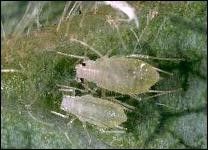
Credit: J. K. Clark, UC
The life cycle of the strawberry aphid includes eggs, nymphs and adult apterae (wingless), and adult alates (winged). Eggs are white-yellowish in color when deposited, but hours later they become shiny and black (Figure 4). Nymphs are small (0.8–1.1 mm long) and similar to adults. Nymphs vary in color from light green to pale yellow (Rondon and Cantliffe 2004). Adults are 1.3–1.5 mm long, pale to yellowish green, and have short setae (hairs) over the body. The antennae are as long or longer than the length of the body. The cornicles are long, pale, and slender, about 1/4 of the body length, and the legs are pale green and almost translucent. Wingless adults are small (0.9-1.3 mm long), elongate oval, translucent, yellowish-white or pale green. Winged adults are medium size (1.3–1.8 mm long) and have a pale greenish abdomen with a brown dorsal patch.
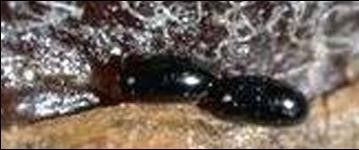
Credit: J. K. Clark, UC
Aphid females can reproduce throughout the year without males; however, oviparae (winged reproductive females and wingless males) may occur in greenhouse and laboratory culture. Oviparae forms have not been reported from the field.
Damage and Importance
Aphid nymphs and adults feed on plant sap, preventing plant growth. Strawberry aphids can cause a reduction in the production and quality of the strawberries, especially when fungus grows on the honeydew that the aphids excrete (Cédola and Greco 2010). Typical symptoms of aphid damage include curled leaves, yellowish spots, and the presence of sticky honeydew. A black sooty mold may develop on the leaves, affecting photosynthesis and possibly reducing plant yields.
The strawberry aphid is also the principal vector of viruses, such as strawberry mild yellow edge virus (SMYEV), strawberry crinkle virus (SCV) and strawberry mottle virus (SMV), in strawberry crops (Krczal 1982; Cédola and Greco 2010). Strawberry mild yellow edge virus (SMYEV) and strawberry crinkle virus (SCV) belong to the most pathogenic viruses affecting strawberry (Krczal, 1979). Strawberry plants imported from a Nova Scotia nursery were infected with SMYEV and SMV and caused damage to Florida strawberries in 2012 (Martin and Tzanetakis 2013).
SMYEV and SCV are persistent, circulative-transmitted viruses where the aphids need to feed on an infected plant for hours or days to acquire and spread the virus. Viruses spread through the body of the aphid and remain in the aphid through most of its life. On the other hand, SMV is semi-persistently transmitted, which means that aphids can receive and transmit the virus within only a few minutes as they probe infected plants and then move to nearby healthy plants.
Depending on the virus, leaves will become discolored and plants take on a compact appearance. These virus symptoms range from stunted plant growth with a yellow edge to the younger leaves (SMYEV, SCV, SMV), to leaves with yellowish spots that become crinkled (SCV, SMV).
Control
Effective and timely control of the strawberry aphid is essential in strawberry production due to rapid population growth. Control of the strawberry aphid starts with inspection of incoming transplants to remove aphid-infested plants. Monitoring should begin early in the season and continue throughout the duration of the crop. Inspect leaflets and shoots carefully at random throughout the field. A sample size of fifty leaflets or shoots is recommended, but will vary according to farm size. Yellow sticky cards can be used to trap the winged form; however, if winged forms are found, a well-established aphid population is already in the crop. The presence of ants, feeding on honeydew produced by the aphids, is also a sign of heavy aphid infestation. Chemical control should be considered as a first measure if viruses transmitted by this aphid are detected. For chemical control options consult: https://edis.ifas.ufl.edu/PI037 or https://edis.ifas.ufl.edu/cv134. Control of aphids will reduce the rate of virus spread. However, even insecticide treatments will not provide complete protection against incoming viruliferous aphids (Converse 2002). It takes only one aphid to spread the virus in your crop; however, keep in mind that not all strawberry aphids transmit viruses.
Biological Based Control Program
There is no extended information regarding the effect of natural enemies specifically on the strawberry aphid in Florida., In the UK, the lacewing larvae, Chrysoperla carnea, consumed several strawberry aphids during their development. Additionally, open field experiments showed that strawberry aphid numbers were significantly reduced at release rates of eight lacewing larvae per plant (Easterbrook et al. 2007). There are several biological control options for aphid control. Lady beetles Hippodamia convergens Güerin-Menevielle (Figure 5) and Coleomegilla maculata (DeGeer) (Figure 6) are excellent aphid feeders (Rondon et al. 2004). Lacewings Chrysoperla spp. (Figure 7), and the predatory midge Aphidoletes aphidimyza L. are also voracious predators of aphids (Figure 8) (Heinz, 1998).
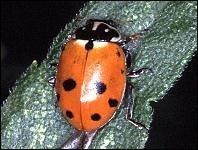
Credit: J. P. Michaud, UF/IFAS

Credit: M. E. Rice, KSU

Credit: OSU
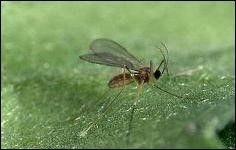
Credit: J. K. Clark, UC
Parasitoids are very specific to the species of aphid they attack. So far, there are no reports in the literature for strawberry aphid control by parasitoid wasps.
If biological control is used:
-
Reduce or limit the use of broad spectrum pesticides (e.g., pyrethroids, organophosphates)
-
Preventive releases are recommended
-
Monitor weekly to detect first sign of pest
-
Using a light soap before release of beneficials is suggested, because if honey dew is present, it may interfere with the search capability of the predator.
Literature Cited
Blackman, R.L. and V.F. Eastop. 2000. Aphids on the World's Crops: An Identification and Information Guide. 2nd Edition. Ed Willey. N.Y. p. 324.
Cédola, C. and N. Greco. 2010. Presence of the aphid Chaetosiphon fragaefolii on strawberry in Argentina. Journal of Insect Science 10 (9). https://doi.org/10.1673/031.010.0901
Converse, R.H. 2002. Virus Diseases of Small Fruits. U.S. Department of Agriculture, Agricultural Research Service. 631. p. 100.
Easterbrook, Fitzgerald, J.D., and Solomon, M.G. 2007. Suppression of aphids on strawberry by augmentative releases of larvae of the lacewing Chrysoperla carnea (Stephens). Biocontrol Science and Technology 9: 893-900,
Frazier, N.W. 1974. Strawberry Crinkle Virus, pp. 1-18. In Plant Disease Report No. 58.
Heinz, K.M. 1998. Dispersal and Dispersion of Aphids and Selected Natural Enemies in Spatially Subdivided Greenhouse Environments. Environ. Entomol. 27:1029-1038. https://doi.org/10.1093/ee/27.4.1029
Krczal, H. 1979. Transmission of the Strawberry Mild Yellow Edge and Strawberry Crinkle Virus by the Strawberry Aphid Chaetosiphon fragaefolli. Acta Horticulturae 95:23-30.
Krczal, H. 1982. Investigations on the Biology of the Strawberry Aphid (Chaetosiphon fragaefolli), the Most Important Vector of Strawberry Viruses in West Germany. Acta Horticulturae 129:63-68. https://doi.org/10.17660/ActaHortic.1982.129.11
Martin, R. R. and I.E. Tzanetakis. 2013. High risk strawberry viruses by region in the United States and Canada: implications for certification, nurseries, and fruit production. Plant Disease 97: 1358-1362. https://doi.org/10.1094/PDIS-09-12-0842-RE
Rondon, S.I. and D.J. Cantliffe. 2004. The Strawberry Aphid, Chaetosiphon fragaefolli (Homoptera: Aphididae): A New Pest for the Strawberry Crop in Florida. Florida Entomol. 87:612-615. https://doi.org/10.1653/0015-4040(2004)087[0612:CFHAAP]2.0.CO;2
Rondon, S.I., D.J. Cantliffe, and J.F. Price. 2004. The Feeding Behavior of the Bigeyed Bug, Minute Pirate Bug, and Pink Spotted Lady Beetle (Coleoptera: Coccinellidae) Relative to Main Strawberry Pests. Environ. Entomol. 33:1014-1019. https://doi.org/10.1603/0046-225X-33.4.1014


